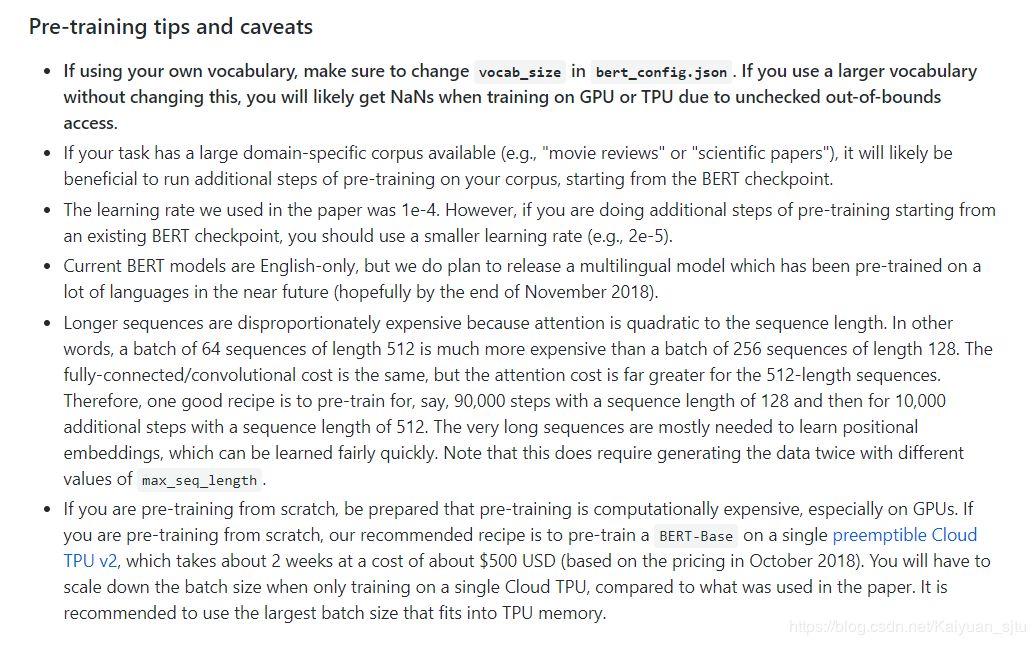BERTBERT源码分析(PART III)
Posted 机器学习算法与自然语言处理
tags:
篇首语:本文由小常识网(cha138.com)小编为大家整理,主要介绍了BERTBERT源码分析(PART III)相关的知识,希望对你有一定的参考价值。
写在前面
继续之前没有介绍完的 Pre-training 部分,在上一篇中()我们已经完成了对输入数据的处理,接下来看看 BERT 是怎么完成「Masked LM」和「Next Sentence Prediction」两个任务的训练。
-
run_pretraining [1]
除了代码块外部,在内部也有注释噢。之前代码黑色背景好像有点不舒服,换成白色试试
另外,把BERT源码分析系列整理成了PDF版本方便阅读,有需要的可以在文末获取(别急着拉到下面,先看完这篇 )
)
任务#1:Masked LM
get_masked_lm_output函数用于计算「任务#1」的训练 loss。输入为 BertModel 的最后一层 sequence_output 输出([batch_size, seq_length, hidden_size]),因为对一个序列的 MASK 标记的预测属于标注问题,需要整个 sequence 的输出状态。
def get_masked_lm_output(bert_config, input_tensor, output_weights, positions,
label_ids, label_weights):
"""Get loss and log probs for the masked LM."""
# 获取mask词的encode
input_tensor = gather_indexes(input_tensor, positions)
with tf.variable_scope("cls/predictions"):
# 在输出之前添加一个非线性变换,只在预训练阶段起作用
with tf.variable_scope("transform"):
input_tensor = tf.layers.dense(
input_tensor,
units=bert_config.hidden_size,
activation=modeling.get_activation(bert_config.hidden_act),
kernel_initializer=modeling.create_initializer(
bert_config.initializer_range))
input_tensor = modeling.layer_norm(input_tensor)
# output_weights是和传入的word embedding一样的
# 这里再添加一个bias
output_bias = tf.get_variable(
"output_bias",
shape=[bert_config.vocab_size],
initializer=tf.zeros_initializer())
logits = tf.matmul(input_tensor, output_weights, transpose_b=True)
logits = tf.nn.bias_add(logits, output_bias)
log_probs = tf.nn.log_softmax(logits, axis=-1)
# label_ids表示mask掉的Token的id
label_ids = tf.reshape(label_ids, [-1])
label_weights = tf.reshape(label_weights, [-1])
one_hot_labels = tf.one_hot(
label_ids, depth=bert_config.vocab_size, dtype=tf.float32)
# 但是由于实际MASK的可能不到20,比如只MASK18,那么label_ids有2个0(padding)
# 而label_weights=[1, 1, ...., 0, 0],说明后面两个label_id是padding的,计算loss要去掉。
per_example_loss = -tf.reduce_sum(log_probs * one_hot_labels, axis=[-1])
numerator = tf.reduce_sum(label_weights * per_example_loss)
denominator = tf.reduce_sum(label_weights) + 1e-5
loss = numerator / denominator
return (loss, per_example_loss, log_probs)
任务#2 Next Sentence Prediction
get_next_sentence_output函数用于计算「任务#2」的训练 loss。输入为 BertModel 的最后一层 pooled_output 输出([batch_size, hidden_size]),因为该任务属于二分类问题,所以只需要每个序列的第一个 token【CLS】即可。
def get_next_sentence_output(bert_config, input_tensor, labels):
"""Get loss and log probs for the next sentence prediction."""
# 标签0表示 下一个句子关系成立;标签1表示 下一个句子关系不成立。
# 这个分类器的参数在实际Fine-tuning阶段会丢弃掉
with tf.variable_scope("cls/seq_relationship"):
output_weights = tf.get_variable(
"output_weights",
shape=[2, bert_config.hidden_size],
initializer=modeling.create_initializer(bert_config.initializer_range))
output_bias = tf.get_variable(
"output_bias", shape=[2], initializer=tf.zeros_initializer())
logits = tf.matmul(input_tensor, output_weights, transpose_b=True)
logits = tf.nn.bias_add(logits, output_bias)
log_probs = tf.nn.log_softmax(logits, axis=-1)
labels = tf.reshape(labels, [-1])
one_hot_labels = tf.one_hot(labels, depth=2, dtype=tf.float32)
per_example_loss = -tf.reduce_sum(one_hot_labels * log_probs, axis=-1)
loss = tf.reduce_mean(per_example_loss)
return (loss, per_example_loss, log_probs)
自定义模型
module_fn_builder函数,用于构造 Estimator 使用的model_fn。定义好了上述两个训练任务,就可以写出训练过程,之后将训练集传入自动训练。
def model_fn_builder(bert_config, init_checkpoint, learning_rate,
num_train_steps, num_warmup_steps, use_tpu,
use_one_hot_embeddings):
def model_fn(features, labels, mode, params):
tf.logging.info("*** Features ***")
for name in sorted(features.keys()):
tf.logging.info(" name = %s, shape = %s" % (name, features[name].shape))
input_ids = features["input_ids"]
input_mask = features["input_mask"]
segment_ids = features["segment_ids"]
masked_lm_positions = features["masked_lm_positions"]
masked_lm_ids = features["masked_lm_ids"]
masked_lm_weights = features["masked_lm_weights"]
next_sentence_labels = features["next_sentence_labels"]
is_training = (mode == tf.estimator.ModeKeys.TRAIN)
# 创建Transformer实例对象
model = modeling.BertModel(
config=bert_config,
is_training=is_training,
input_ids=input_ids,
input_mask=input_mask,
token_type_ids=segment_ids,
use_one_hot_embeddings=use_one_hot_embeddings)
# 获得MASK LM任务的批损失,平均损失以及预测概率矩阵
(masked_lm_loss,
masked_lm_example_loss, masked_lm_log_probs) = get_masked_lm_output(
bert_config, model.get_sequence_output(), model.get_embedding_table(),
masked_lm_positions, masked_lm_ids, masked_lm_weights)
# 获得NEXT SENTENCE PREDICTION任务的批损失,平均损失以及预测概率矩阵
(next_sentence_loss, next_sentence_example_loss,
next_sentence_log_probs) = get_next_sentence_output(
bert_config, model.get_pooled_output(), next_sentence_labels)
# 总的损失定义为两者之和
total_loss = masked_lm_loss + next_sentence_loss
# 获取所有变量
tvars = tf.trainable_variables()
initialized_variable_names = {}
scaffold_fn = None
# 如果有之前保存的模型,则进行恢复
if init_checkpoint:
(assignment_map, initialized_variable_names
) = modeling.get_assignment_map_from_checkpoint(tvars, init_checkpoint)
if use_tpu:
def tpu_scaffold():
tf.train.init_from_checkpoint(init_checkpoint, assignment_map)
return tf.train.Scaffold()
scaffold_fn = tpu_scaffold
else:
tf.train.init_from_checkpoint(init_checkpoint, assignment_map)
tf.logging.info("**** Trainable Variables ****")
for var in tvars:
init_string = ""
if var.name in initialized_variable_names:
init_string = ", *INIT_FROM_CKPT*"
tf.logging.info(" name = %s, shape = %s%s", var.name, var.shape,
init_string)
output_spec = None
# 训练过程,获得spec
if mode == tf.estimator.ModeKeys.TRAIN:
train_op = optimization.create_optimizer(
total_loss, learning_rate, num_train_steps, num_warmup_steps, use_tpu)
output_spec = tf.contrib.tpu.TPUEstimatorSpec(
mode=mode,
loss=total_loss,
train_op=train_op,
scaffold_fn=scaffold_fn)
# 验证过程spec
elif mode == tf.estimator.ModeKeys.EVAL:
def metric_fn(masked_lm_example_loss, masked_lm_log_probs, masked_lm_ids,
masked_lm_weights, next_sentence_example_loss,
next_sentence_log_probs, next_sentence_labels):
"""计算损失和准确率"""
masked_lm_log_probs = tf.reshape(masked_lm_log_probs,
[-1, masked_lm_log_probs.shape[-1]])
masked_lm_predictions = tf.argmax(
masked_lm_log_probs, axis=-1, output_type=tf.int32)
masked_lm_example_loss = tf.reshape(masked_lm_example_loss, [-1])
masked_lm_ids = tf.reshape(masked_lm_ids, [-1])
masked_lm_weights = tf.reshape(masked_lm_weights, [-1])
masked_lm_accuracy = tf.metrics.accuracy(
labels=masked_lm_ids,
predictions=masked_lm_predictions,
weights=masked_lm_weights)
masked_lm_mean_loss = tf.metrics.mean(
values=masked_lm_example_loss, weights=masked_lm_weights)
next_sentence_log_probs = tf.reshape(
next_sentence_log_probs, [-1, next_sentence_log_probs.shape[-1]])
next_sentence_predictions = tf.argmax(
next_sentence_log_probs, axis=-1, output_type=tf.int32)
next_sentence_labels = tf.reshape(next_sentence_labels, [-1])
next_sentence_accuracy = tf.metrics.accuracy(
labels=next_sentence_labels, predictions=next_sentence_predictions)
next_sentence_mean_loss = tf.metrics.mean(
values=next_sentence_example_loss)
return {
"masked_lm_accuracy": masked_lm_accuracy,
"masked_lm_loss": masked_lm_mean_loss,
"next_sentence_accuracy": next_sentence_accuracy,
"next_sentence_loss": next_sentence_mean_loss,
}
eval_metrics = (metric_fn, [
masked_lm_example_loss, masked_lm_log_probs, masked_lm_ids,
masked_lm_weights, next_sentence_example_loss,
next_sentence_log_probs, next_sentence_labels
])
output_spec = tf.contrib.tpu.TPUEstimatorSpec(
mode=mode,
loss=total_loss,
eval_metrics=eval_metrics,
scaffold_fn=scaffold_fn)
else:
raise ValueError("Only TRAIN and EVAL modes are supported: %s" % (mode))
return output_spec
return model_fn
主函数
基于上述函数实现训练过程
def main(_):
tf.logging.set_verbosity(tf.logging.INFO)
if not FLAGS.do_train and not FLAGS.do_eval:
raise ValueError("At least one of `do_train` or `do_eval` must be True.")
bert_config = modeling.BertConfig.from_json_file(FLAGS.bert_config_file)
tf.gfile.MakeDirs(FLAGS.output_dir)
input_files = []
for input_pattern in FLAGS.input_file.split(","):
input_files.extend(tf.gfile.Glob(input_pattern))
tf.logging.info("*** Input Files ***")
for input_file in input_files:
tf.logging.info(" %s" % input_file)
tpu_cluster_resolver = None
if FLAGS.use_tpu and FLAGS.tpu_name:
tpu_cluster_resolver = tf.contrib.cluster_resolver.TPUClusterResolver(
FLAGS.tpu_name, zone=FLAGS.tpu_zone, project=FLAGS.gcp_project)
is_per_host = tf.contrib.tpu.InputPipelineConfig.PER_HOST_V2
run_config = tf.contrib.tpu.RunConfig(
cluster=tpu_cluster_resolver,
master=FLAGS.master,
model_dir=FLAGS.output_dir,
save_checkpoints_steps=FLAGS.save_checkpoints_steps,
tpu_config=tf.contrib.tpu.TPUConfig(
iterations_per_loop=FLAGS.iterations_per_loop,
num_shards=FLAGS.num_tpu_cores,
per_host_input_for_training=is_per_host))
# 自定义模型用于estimator训练
model_fn = model_fn_builder(
bert_config=bert_config,
init_checkpoint=FLAGS.init_checkpoint,
learning_rate=FLAGS.learning_rate,
num_train_steps=FLAGS.num_train_steps,
num_warmup_steps=FLAGS.num_warmup_steps,
use_tpu=FLAGS.use_tpu,
use_one_hot_embeddings=FLAGS.use_tpu)
# 如果没有TPU,会自动转为CPU/GPU的Estimator
estimator = tf.contrib.tpu.TPUEstimator(
use_tpu=FLAGS.use_tpu,
model_fn=model_fn,
config=run_config,
train_batch_size=FLAGS.train_batch_size,
eval_batch_size=FLAGS.eval_batch_size)
if FLAGS.do_train:
tf.logging.info("***** Running training *****")
tf.logging.info(" Batch size = %d", FLAGS.train_batch_size)
train_input_fn = input_fn_builder(
input_files=input_files,
max_seq_length=FLAGS.max_seq_length,
max_predictions_per_seq=FLAGS.max_predictions_per_seq,
is_training=True)
estimator.train(input_fn=train_input_fn, max_steps=FLAGS.num_train_steps)
if FLAGS.do_eval:
tf.logging.info("***** Running evaluation *****")
tf.logging.info(" Batch size = %d", FLAGS.eval_batch_size)
eval_input_fn = input_fn_builder(
input_files=input_files,
max_seq_length=FLAGS.max_seq_length,
max_predictions_per_seq=FLAGS.max_predictions_per_seq,
is_training=False)
result = estimator.evaluate(
input_fn=eval_input_fn, steps=FLAGS.max_eval_steps)
output_eval_file = os.path.join(FLAGS.output_dir, "eval_results.txt")
with tf.gfile.GFile(output_eval_file, "w") as writer:
tf.logging.info("***** Eval results *****")
for key in sorted(result.keys()):
tf.logging.info(" %s = %s", key, str(result[key]))
writer.write("%s = %s
" % (key, str(result[key])))
代码测试
预训练运行脚本
python run_pretraining.py
--input_file=/tmp/tf_examples.tfrecord
--output_dir=/tmp/pretraining_output
--do_train=True
--do_eval=True
--bert_config_file=$BERT_BASE_DIR/bert_config.json
--init_checkpoint=$BERT_BASE_DIR/bert_model.ckpt
--train_batch_size=32
--max_seq_length=128
--max_predictions_per_seq=20
--num_train_steps=20
--num_warmup_steps=10
--learning_rate=2e-5
之后你可以得到类似以下输出日志:
***** Eval results *****
global_step = 20
loss = 0.0979674
masked_lm_accuracy = 0.985479
masked_lm_loss = 0.0979328
next_sentence_accuracy = 1.0
next_sentence_loss = 3.45724e-05
最后贴一个预训练过程的 tips【反正我也做不了,看看就行= 。=】
Over~BERT源码系列到这里就结束啦。
PS.到现在为止,BERT也更新了很多比如Whole Word Masking等等,所以之前有错误的还请大家一定指出,我好及时修正~
本文参考资料
run_pretraining: https://github.com/google-research/bert/blob/master/run_pretraining.py
推荐阅读:
推荐阅读:
以上是关于BERTBERT源码分析(PART III)的主要内容,如果未能解决你的问题,请参考以下文章